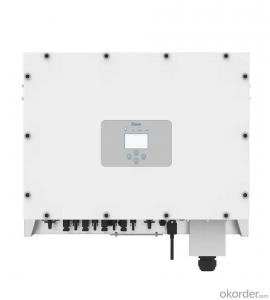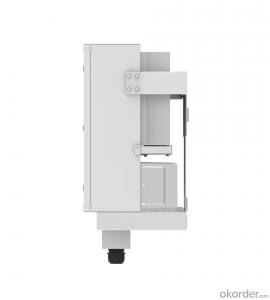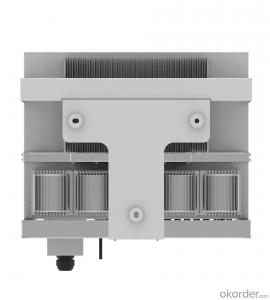SUN-35/40/45/50K-G-LV | 35-50KW | Three Phase | 4 MPPT | Low Voltage 127/220Vac
- Loading Port:
- Ningbo
- Payment Terms:
- TT OR LC
- Min Order Qty:
- 100 pc
- Supply Capability:
- 5000 pc/month
OKorder Service Pledge
OKorder Financial Service
You Might Also Like
Item specifice
| Technical Data | ||||||
| Model | SUN-35K-G02-LV | SUN-40K-G-LV | SUN-45K-G-LV | SUN-50K-G-LV | ||
| Input Side | ||||||
| Max. DC Input Power (kW) | 45.5 | 52 | 58.5 | 65 | ||
| Max. DC Input Voltage (V) | 800 | |||||
| Start-up DC Input Voltage (V) | 250 | |||||
| MPPT Operating Range (V) | 200~700 | |||||
| Max. DC Input Current (A) | 30+30+30+30 | 40+40+40+40 | ||||
| Max. Short Circuit Current (A) | 45+45+45+45 | 60+60+60+60 | ||||
| Number of MPPT / Strings per MPPT | 4/3 | 4/4 | ||||
| Output Side | ||||||
| Rated Output Power (kW) | 35 | 40 | 345 | 50 | ||
| Max. Active Power (kW) | 38.5 | 44 | 49.5 | 55 | ||
| Nominal Output Voltage / Range (V) | 3L/N/PE 127/0.85Un-1.1Un,220 /0.85Un-1.1Un (this may vary with grid standards) | |||||
| Rated Grid Frequency (Hz) | 60 / 50 (Optional) | |||||
| Operating Phase | Three phase | |||||
| Rated AC Grid Output Current (A) | 91.9 | 104.9 | 118.1 | 131.2 | ||
| Max. AC Output Current (A) | 101.1 | 115.5 | 129.9 | 144.4 | ||
| Output Power Factor | 0.8 leading to 0.8 lagging | |||||
| Grid Current THD | <3% | |||||
| DC Injection Current (mA) | <0.5% | |||||
| Grid Frequency Range | 57~62 | |||||
| Efficiency | ||||||
| Max. Efficiency | 98.7% | |||||
| Euro Efficiency | 98.3% | |||||
| MPPT Efficiency | >99% | |||||
| Protection | ||||||
| DC Reverse-Polarity Protection | Yes | |||||
| AC Short Circuit Protection | Yes | |||||
| AC Output Overcurrent Protection | Yes | |||||
| Output Overvoltage Protection | Yes | |||||
| Insulation Resistance Protection | Yes | |||||
| Ground Fault Monitoring | Yes | |||||
| Anti-islanding Protection | Yes | |||||
| Temperature Protection | Yes | |||||
| Integrated DC Switch | Yes | |||||
| Remote software upload | Yes | |||||
| Remote change of operating parameters | Yes | |||||
| Surge protection | DC Type II / AC Type II | |||||
| General Data | ||||||
| Size (mm) | 700W×575H×297D | |||||
| Weight (kg) | 60 | |||||
| Topology | Transformerless | |||||
| Internal Consumption | <1W (Night) | |||||
| Running Temperature | -25~65℃, >45℃ derating | |||||
| Ingress Protection | IP65 | |||||
| Noise Emission (Typical) | <55 dB | |||||
| Cooling Concept | Smart cooling | |||||
| Max. Operating Altitude Without Derating | 2000m | |||||
| Warranty | 5 years | |||||
| Grid Connection Standard | CEI 0-21, VDE-AR-N 4105, NRS 097, IEC 62116, IEC 61727, G99, G98, VDE 0126-1-1, RD 1699, C10-11 | |||||
| Operating Surroundings Humidity | 0-100% | |||||
| Safety EMC / Standard | IEC/EN 61000-6-1/2/3/4, IEC/EN 62109-1, IEC/EN 62109-2 | |||||
| Features | ||||||
| DC Connection | MC-4 mateable | |||||
| AC Connection | IP65 rated plug | |||||
| Display | LCD 240 × 160 | |||||
| Interface | RS485/RS232/Wifi/LAN | |||||
This series inverter is specially designed for 127/220Vac three-phase system, providing rated power at 35KW, 40KW, 45KW, 50KW. Equipped with large LCD and buttons, easy to operate and maintenance. With compact design and high-power density, this series supports 1.3 DC/AC ratio, saving device investment.
127/220Vac and 60Hz, three phase system
4 MPP tracker, Max. efficiency up to 98.7%
Zero export application, VSG application
String intelligent monitoring (optional)
Wide output voltage range
Type II DC/AC SPD
Anti-PID function (Optional)
- Q:Can a solar inverter be used in systems with different module currents?
- Yes, a solar inverter can be used in systems with different module currents. Solar inverters are designed to convert the DC power produced by the solar panels into AC power for use in the electrical grid or for powering appliances. They typically have a wide range of input voltage and current ratings to accommodate different solar panel configurations. As long as the total power output of the solar panels is within the specifications of the inverter, it can be used in systems with varying module currents.
- Q:How does a solar inverter handle power export limitations imposed by the grid?
- A solar inverter handles power export limitations imposed by the grid through a process called power factor control. The inverter continuously monitors the grid's voltage and frequency, adjusting its power output accordingly. If the grid imposes limitations on power export, the inverter reduces its output to stay within the allowed limits. This ensures that the solar system operates in compliance with the grid regulations and prevents any excess power from flowing back into the grid.
- Q:What is the maximum AC output power of a solar inverter?
- The maximum AC output power of a solar inverter depends on its specifications and capacity. It can range from a few hundred watts for small residential inverters to several megawatts for large-scale commercial or utility-grade inverters.
- Q:What is the difference between a PV grid-connected inverter and an off-grid inverter?
- Grid-connected inverter will be directly sent to the power grid, so to track the frequency of the grid, phase, the equivalent of a current source. Of course, there are some inverters called low-voltage crossing ability, you can do PQ adjustment
- Q:What is the maximum number of parallel inverters that can be installed in a solar system?
- The maximum number of parallel inverters that can be installed in a solar system depends on the specific requirements of the system and the available infrastructure. There is no fixed limit, as it varies based on factors such as the size of the system, the capacity of the inverters, the electrical load, and the design limitations. It is best to consult with a solar system designer or engineer to determine the optimal number of parallel inverters for a particular solar installation.
- Q:What is the role of an anti-islanding feature in a solar inverter?
- The role of an anti-islanding feature in a solar inverter is to ensure the safety of utility workers by preventing the solar system from continuing to generate power during a grid outage. It detects when the grid goes down and immediately disconnects the solar system from the grid, preventing any potential harm or damage that could occur if power is still being fed into the grid.
- Q:How do I choose the right solar inverter for my system?
- When choosing the right solar inverter for your system, there are a few key factors to consider. First, determine the size and capacity of your solar panels to ensure compatibility. Next, consider the type of inverter you need, whether it's a string inverter, micro inverter, or power optimizer. Additionally, assess the efficiency and reliability of the inverter, as well as its warranty and after-sales support. Finally, consider your budget and any specific features you may require, such as monitoring capabilities or grid connectivity options. It's important to research and compare different models to find the one that best fits your specific solar system needs.
- Q:Can a solar inverter be used with a solar-powered agriculture system?
- Yes, a solar inverter can be used with a solar-powered agriculture system. A solar inverter is essential for converting the direct current (DC) electricity produced by solar panels into alternating current (AC) electricity required to power electrical devices and equipment used in the agriculture system. This allows for the efficient utilization of solar energy for various agricultural applications such as irrigation systems, pumps, lighting, and other electrical equipment.
- Q:How does a solar inverter handle voltage drop?
- A solar inverter handles voltage drop by continuously monitoring the voltage levels from the solar panels. If it detects a drop in voltage, it adjusts its internal voltage regulation mechanisms to maintain a stable output voltage. This ensures that the inverter can efficiently convert the incoming DC power from the solar panels into usable AC power without any significant loss or disruption caused by voltage fluctuations.
- Q:Are there any specific installation requirements for solar inverters?
- Solar inverters have specific installation requirements that should be taken into consideration. Here are some important factors to keep in mind: 1. Placement: To ensure optimal performance and durability, solar inverters should be installed in a well-ventilated area, away from direct sunlight and potential heat sources. Additionally, they should be placed in a clean and dry environment. 2. Mounting: Solar inverters can be mounted on walls or placed on flat surfaces. However, it is crucial to follow the manufacturer's guidelines for proper mounting techniques and ensure that they are securely fastened. 3. Wiring: Adequate wiring is essential for connecting the solar panels to the inverter and the inverter to the electrical grid. The wiring should be appropriately sized based on the system's specifications to handle voltage and current requirements without any voltage drop or overheating. 4. Electrical connections: The inverter should be connected to a dedicated circuit breaker or fuse in the main electrical panel. This circuit breaker or fuse must be properly sized to protect the inverter and the electrical system from potential hazards. 5. Clearances: Specific clearances are required to ensure proper ventilation and prevent overheating of solar inverters. The manufacturer's guidelines should be followed to determine the necessary clearances around the inverter. 6. Monitoring and safety devices: Certain inverters may require additional monitoring and safety devices, such as surge protectors, arc fault circuit interrupters (AFCIs), or rapid shutdown devices. These devices should be installed according to the manufacturer's instructions and local electrical codes. 7. Compliance with regulations: Compliance with local electrical codes and regulations is crucial during the installation of solar inverters. This may include obtaining necessary permits and inspections to ensure a safe and compliant installation. To ensure that all specific requirements are met for your particular system, it is highly recommended to seek guidance from a professional solar installer or electrician who has expertise in solar inverter installations.
1. Manufacturer Overview |
|
|---|---|
| Location | |
| Year Established | |
| Annual Output Value | |
| Main Markets | |
| Company Certifications | |
2. Manufacturer Certificates |
|
|---|---|
| a) Certification Name | |
| Range | |
| Reference | |
| Validity Period | |
3. Manufacturer Capability |
|
|---|---|
| a)Trade Capacity | |
| Nearest Port | |
| Export Percentage | |
| No.of Employees in Trade Department | |
| Language Spoken: | |
| b)Factory Information | |
| Factory Size: | |
| No. of Production Lines | |
| Contract Manufacturing | |
| Product Price Range | |
Send your message to us
SUN-35/40/45/50K-G-LV | 35-50KW | Three Phase | 4 MPPT | Low Voltage 127/220Vac
- Loading Port:
- Ningbo
- Payment Terms:
- TT OR LC
- Min Order Qty:
- 100 pc
- Supply Capability:
- 5000 pc/month
OKorder Service Pledge
OKorder Financial Service
Similar products
New products
Hot products
Related keywords






























